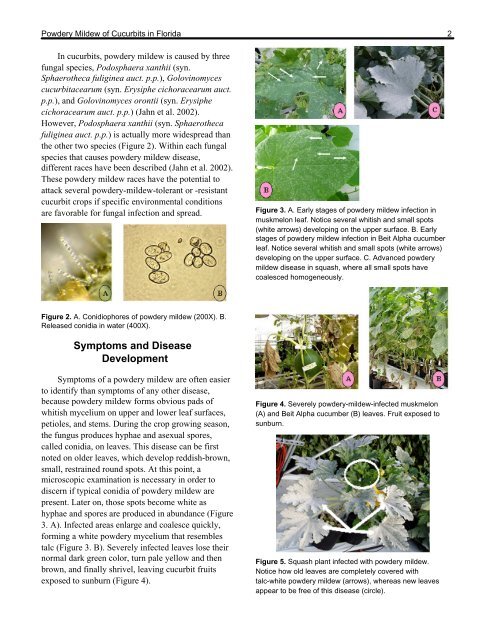Powdery Mildew of Cucurbits in Florida - Orange County Extension ...
Powdery Mildew of Cucurbits in Florida - Orange County Extension ...
Powdery Mildew of Cucurbits in Florida - Orange County Extension ...
Create successful ePaper yourself
Turn your PDF publications into a flip-book with our unique Google optimized e-Paper software.
<strong>Powdery</strong> <strong>Mildew</strong> <strong>of</strong> <strong>Cucurbits</strong> <strong>in</strong> <strong>Florida</strong> 2<br />
In cucurbits, powdery mildew is caused by three<br />
fungal species, Podosphaera xanthii (syn.<br />
Sphaerotheca fulig<strong>in</strong>ea auct. p.p.), Golov<strong>in</strong>omyces<br />
cucurbitacearum (syn. Erysiphe cichoracearum auct.<br />
p.p.), and Golov<strong>in</strong>omyces orontii (syn. Erysiphe<br />
cichoracearum auct. p.p.) (Jahn et al. 2002).<br />
However, Podosphaera xanthii (syn. Sphaerotheca<br />
fulig<strong>in</strong>ea auct. p.p.) is actually more widespread than<br />
the other two species (Figure 2). With<strong>in</strong> each fungal<br />
species that causes powdery mildew disease,<br />
different races have been described (Jahn et al. 2002).<br />
These powdery mildew races have the potential to<br />
attack several powdery-mildew-tolerant or -resistant<br />
cucurbit crops if specific environmental conditions<br />
are favorable for fungal <strong>in</strong>fection and spread.<br />
Figure 2. A. Conidiophores <strong>of</strong> powdery mildew (200X). B.<br />
Released conidia <strong>in</strong> water (400X).<br />
Symptoms and Disease<br />
Development<br />
Symptoms <strong>of</strong> a powdery mildew are <strong>of</strong>ten easier<br />
to identify than symptoms <strong>of</strong> any other disease,<br />
because powdery mildew forms obvious pads <strong>of</strong><br />
whitish mycelium on upper and lower leaf surfaces,<br />
petioles, and stems. Dur<strong>in</strong>g the crop grow<strong>in</strong>g season,<br />
the fungus produces hyphae and asexual spores,<br />
called conidia, on leaves. This disease can be first<br />
noted on older leaves, which develop reddish-brown,<br />
small, restra<strong>in</strong>ed round spots. At this po<strong>in</strong>t, a<br />
microscopic exam<strong>in</strong>ation is necessary <strong>in</strong> order to<br />
discern if typical conidia <strong>of</strong> powdery mildew are<br />
present. Later on, those spots become white as<br />
hyphae and spores are produced <strong>in</strong> abundance (Figure<br />
3. A). Infected areas enlarge and coalesce quickly,<br />
form<strong>in</strong>g a white powdery mycelium that resembles<br />
talc (Figure 3. B). Severely <strong>in</strong>fected leaves lose their<br />
normal dark green color, turn pale yellow and then<br />
brown, and f<strong>in</strong>ally shrivel, leav<strong>in</strong>g cucurbit fruits<br />
exposed to sunburn (Figure 4).<br />
Figure 3. A. Early stages <strong>of</strong> powdery mildew <strong>in</strong>fection <strong>in</strong><br />
muskmelon leaf. Notice several whitish and small spots<br />
(white arrows) develop<strong>in</strong>g on the upper surface. B. Early<br />
stages <strong>of</strong> powdery mildew <strong>in</strong>fection <strong>in</strong> Beit Alpha cucumber<br />
leaf. Notice several whitish and small spots (white arrows)<br />
develop<strong>in</strong>g on the upper surface. C. Advanced powdery<br />
mildew disease <strong>in</strong> squash, where all small spots have<br />
coalesced homogeneously.<br />
Figure 4. Severely powdery-mildew-<strong>in</strong>fected muskmelon<br />
(A) and Beit Alpha cucumber (B) leaves. Fruit exposed to<br />
sunburn.<br />
Figure 5. Squash plant <strong>in</strong>fected with powdery mildew.<br />
Notice how old leaves are completely covered with<br />
talc-white powdery mildew (arrows), whereas new leaves<br />
appear to be free <strong>of</strong> this disease (circle).
















